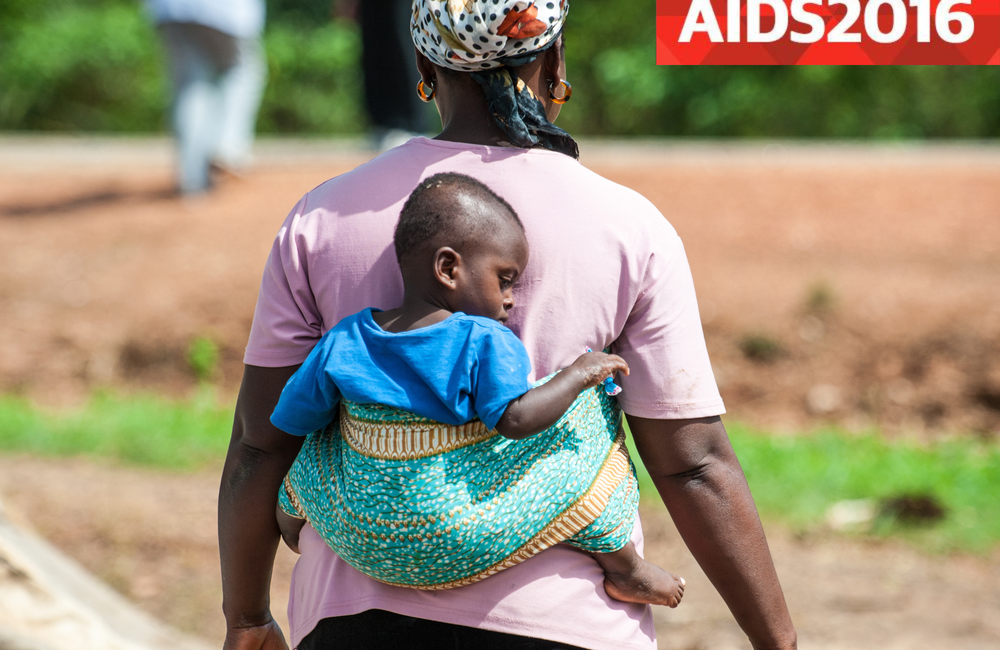
Mother-to-child transmission (MTCT) of HIV at population level was just over 4% at 18 months follow-up in South Africa, Ameena Goga, presenting on behalf of the South African prevention of mother-to-child transmission (PMTCT) Evaluation Group, told participants at the 21st International AIDS Conference (AIDS 2016) in Durban on Tuesday.
Although countries are working towards virtual elimination of MTCT, and the numbers of infants born with HIV or infected post-partum have declined sharply since the introduction of combination antiretroviral therapy for mothers – Option B and Option B+ – the effectiveness of PMTCT programmes needs to be monitored in order to understand where infants are still becoming infected and what can be done to drive down transmission.
Greater clarity about when infections are occurring after delivery can also help target interventions.
Data on national 18- to 24-month HIV-free survival, the gold standard measurement of PMTCT programme effectiveness, is very limited in resource-poor, high HIV prevalence settings. Dr. Goga cited just four studies undertaken since 2001.
Among 1797 (71%) HIV-exposed infants, cumulative MTCT at 18 months was 4.3% (95% CI: 3.7-5%) as South Africa transitioned to Option B. Eight-one per cent of MTCT and 67% of MTCT or death occurred within the first six months after birth highlighting this critical time period for following up HIV-exposed infants.
Among infants alive at six weeks and followed up between six weeks and 18 months HIV-free survival was 93.7% (95% CI: 92.2-94.8%).
From 2012 to 2014, Dr. Goga and her colleagues conducted a national evaluation to measure MTCT of HIV and HIV-free survival. This was at a time when PMTCT policy transitioned from Option A to Option B. The primary research questions comprised: among HIV-exposed infants what is the national population level risk of MTCT or MTCT or death at six weeks, three, six, nine, 12, 15 and 18 months?
A closed cohort of HIV-exposed infants was developed from a nationally representative cross-sectional survey conducted between 2012 and 2013 to estimate early (four to eight weeks postpartum) MTCT. The findings are to be published shortly. To determine national estimates of 18-month HIV-free survival assuming a 5% MTCT rate and a 5% death rate, a target sample size of 1620 was needed.
The South African PMTCT Evaluation Group undertook three national surveys to measure national PMTCT effectiveness: in 2010 when health policy provided maternal zidovudine from 14 weeks into the pregnancy and single dose nevirapine during labour and infant nevirapine during breastfeeding (Option A); in 2011-12 and in 2012-13 during which time policy changed to triple antiretroviral therapy for all women living with HIV during pregnancy and breastfeeding (Option B). [Option B+ became policy in January 2015].
Facilities (580) comprising public primary health clinics and community health clinics offering immunisation services in all nine provinces were randomly selected.
Infant dried blood spot specimens (iDBS) were taken at immunisation visits at four to eight weeks of age and tested for exposure to HIV, and if positive tested for infection using total nucleic acid polymerase chain reaction.
In the 9120 infant dried blood spot specimens taken at four to eight weeks of age the national weighted infant HIV exposure prevalence and the national weighted risk of early mother-to-child transmission was 33.1% (95% CI: 31.8-34.4%) and 2.6% (95% CI: 2.0-3.2), respectively. Early MTCT across provinces ranged from 1.5% to 5.4%.
All HIV-exposed infants, both antibody and maternal self-reported, were invited for facility-based follow-up at three, six, nine, 12, 15 and 18 months. Caregivers were interviewed and infants tested at each visit.
Of the target sample comprising 2811 eligible HIV-exposed infants 6% did not give follow-up consent. At each time point 1600 to 1700 infants were followed up.
Seventy-one per cent (1797) of HIV-exposed infants were followed up at 18 months.
Cumulative MTCT by three and six months was 2.7% (95% CI: 2.6-12.6) and 3.5% (95% CI: 3.1-4.4), respectively.
At nine, 12 and 15 months, cumulative MTCT was 3.7% (95% CI: 3.2-4.6) 3.9% (95% CI: 3.4-4.7) and 4.1% (95% CI: 3.5-4.8), respectively.
The cumulative MTCT rate at 18 months was 4.3% (95% CI: 3.7-5.0). The most rapid increase in MTCT was seen within the first six months after birth, slowly increasing thereafter. Over 50% of postnatal MTCT occurred by six months. Postnatal MTCT and intrauterine and early postnatal MTCT accounted for 39% and 61% of 18 month MTCT, respectively.
Similarly the most rapid increase in MTCT or death took place within the first six months.
Limitations, Dr. Goga noted, included: the exclusion of infants without consent or who died before six weeks of age; a closed cohort may underestimate MTCT and HIV-free survival. The strengths of the study, Dr Goga concluded, lay in the nationally representative sample and the fact that 94.1% of the eligible population participated in the follow-up.
Goga A et al. Highest risk of mother-to-child transmission of HIV or death in the first 6 months postpartum: results from 18 month follow-up of an HIV-exposed cohort, South Africa. 21st International AIDS Conference, Durban, abstract TUAE0106, 2016.
View the abstract on the conference website.
Download the presentation slides from the conference website.
